A Novel Reconfigurable Gate-Biasing Technique for Extending Dynamic Range in CMOS RF-DC Rectifiers Targeting RFEH Applications
Abstract
1. Introduction
2. Proposed Work
2.1. Background
2.2. Architecture and Working Principle
2.3. Realization of Circuit
3. Experimental Results
4. Conclusions
Author Contributions
Funding
Institutional Review Board Statement
Informed Consent Statement
Data Availability Statement
Conflicts of Interest
Abbreviations
| CCDD | Cross-coupled differential drive |
| PCE | Power conversion efficiency |
| PDR | Power dynamic range |
| CMOS | Complimentary metal oxide semiconductor |
| RF | Radio frequency |
| DC | Direct current |
| VTH | Threshold voltage |
| Vout | Rectifier output voltage |
| VGS | Gate-to-source voltage |
| Vsb | Source-to-body voltage |
| VDC | External voltage source of comparator |
| Vref | Reference voltage |
| Irev | Reverse leakage current |
| Pin | Input power in dBm |
References
- Rani, A.; Mishra, V.K.; Mishra, A.K.; Kumar, V.; Pandey, N.K. Role and Significance of Internet of Things (IoT) in Industry 4.0. In Proceedings of the 2024 3rd International conference on Power Electronics and IoT Applications in Renewable Energy and its Control (PARC), Mathura, India, 23–24 February 2024; pp. 199–202. [Google Scholar] [CrossRef]
- Molefi, M.; Markus, E.D.; Abu-Mahfouz, A. Wireless Power Transfer for IoT Devices—A Review. In Proceedings of the 2019 International Multidisciplinary Information Technology and Engineering Conference (IMITEC), Vanderbijlpark, South Africa, 21–22 November 2019; pp. 1–8. [Google Scholar] [CrossRef]
- Makhetha, M.J.; Markus, E.D.; Abu-Mahfouz, A.M. Integration of wireless power transfer and low power wide area networks in IoT applications—A review. Sensors Int. 2024, 5, 100284. [Google Scholar] [CrossRef]
- Li, L.; Jiang, Y. Design of High-Efficiency Microwatt RF Energy Harvesting System. IEEE Trans. Power Electron. 2024, 39, 5883–5901. [Google Scholar] [CrossRef]
- Chong, G.; Ramiah, H.; Yin, J.; Rajendran, J.; Wong, W.R.; Mak, P.-I.; Martins, R.P. Ambient RF energy harvesting system: A review on integrated circuit design. Analog. Integr. Circuits Signal Process. 2018, 97, 515–531. [Google Scholar] [CrossRef]
- Ramalingam, L.; Mariappan, S.; Parameswaran, P.; Rajendran, J.; Nitesh, R.S.; Kumar, N.; Nathan, A.; Yarman, B.S. The Advancement of Radio Frequency Energy Harvesters (RFEHs) as a Revolutionary Approach for Solving Energy Crisis in Wireless Communication Devices: A Review. IEEE Access 2021, 9, 106107–106139. [Google Scholar] [CrossRef]
- Chun, A.C.C.; Ramiah, H.; Mekhilef, S. Wide Power Dynamic Range CMOS RF-DC Rectifier for RF Energy Harvesting System: A Review. IEEE Access 2022, 10, 23948–23963. [Google Scholar] [CrossRef]
- Papadopoulou, M.S.; Boursianis, A.D.; Volos, C.K.; Stouboulos, I.N.; Nikolaidis, S.; Goudos, S.K. High-Efficiency Triple-Band RF-to-DC Rectifier Primary Design for RF Energy-Harvesting Systems. Telecom 2021, 2, 271–284. [Google Scholar] [CrossRef]
- Lian, W.X.; Xiang, A.K.J.; Ramiah, H.; Soon, K.L.; Denesh, S.; Sariff, N.; Isa, N.M. Reconfigurable Multiband RF Energy Harvesting System in CMOS for Adaptive Power Efficiency. In Proceedings of the 2024 IEEE 22nd Student Conference on Research and Development (SCOReD), Shah Alam, Malaysia, 19–20 December 2024; pp. 571–576. [Google Scholar] [CrossRef]
- Lee, Y.C.; Ramiah, H.; Choo, A.; Churchill, K.K.P.; Lai, N.S.; Lim, C.C.; Chen, Y.; Mak, P.-I.; Martins, R.P. High-Performance Multiband Ambient RF Energy Harvesting Front-End System for Sustainable IoT Applications—A Review. IEEE Access 2023, 11, 11143–11164. [Google Scholar] [CrossRef]
- Pinuela, M.; Mitcheson, P.D.; Lucyszyn, S. Ambient RF Energy Harvesting in Urban and Semi-Urban Environments. IEEE Trans. Microw. Theory Technol. 2013, 61, 2715–2726. [Google Scholar] [CrossRef]
- Miriyala, P.K.; Srinivas, P.N.; S, N. On-Chip 5&6-GHz RF Energy Harvesting System for Implantable Medical Devices. In Proceedings of the 2024 IEEE International Symposium on Circuits and Systems (ISCAS), Singapore, 19–22 May 2024; pp. 1–5. [Google Scholar] [CrossRef]
- Yue, X.; Chen, Z.; Zou, Y.; Du, S. A Highly Efficient Fully Integrated Active Rectifier for Ultrasonic Wireless Power Transfer. In Proceedings of the 2022 IEEE International Symposium on Circuits and Systems (ISCAS), Austin, TX, USA, 28 May–1 June 2022; pp. 531–535. [Google Scholar] [CrossRef]
- Choo, A.; Lee, Y.C.; Ramiah, H.; Chen, Y.; Mak, P.-I.; Martins, R.P. A High-PCE Range-Extension CMOS Rectifier Employing Advanced Topology Amalgamation Technique for Ambient RF Energy Harvesting. IEEE Trans. Circuits Syst. II Express Briefs 2023, 70, 3747–3751. [Google Scholar] [CrossRef]
- Kotani, K.; Sasaki, A.; Ito, T. High-Efficiency Differential-Drive CMOS Rectifier for UHF RFIDs. IEEE J. Solid-State Circuits 2009, 44, 3011–3018. [Google Scholar] [CrossRef]
- Al-Absi, M.A.; Alkhalifa, I.M.; Mohammed, A.A.; Al-Khulaifi, A.A. A CMOS Rectifier Employing Body Biasing Scheme for RF Energy Harvesting. IEEE Access 2021, 9, 105606–105611. [Google Scholar] [CrossRef]
- Park, J.; Kim, Y.; Cho, Y.; Burm, J. Multi-Stage Reconfigurable RF-DC Converter with Deep-n-Well Biasing Using Body-Isolated MOSFET in 180-nm BCDMOS Process. IEEE Trans. Circuits Syst. II Express Briefs 2023, 70, 3817–3821. [Google Scholar] [CrossRef]
- Jordan, W.; Barakat, A.; Gyawali, B.; Pokharel, R.K. High-Efficiency Platinum-Band CMOS Rectifier Using Modified Body-Biasing Technique. IEEE Technol. Policy Ethics 2024, 34, 1290–1292. [Google Scholar] [CrossRef]
- Yin, J.; Pantoja, E.; Gao, Y.; Stan, M.R. A Feedback Self-adaptive Body Biasing-based RF-DC Rectifier for Highly-sensitive RF Energy Harvesting. In Proceedings of the 2024 IEEE International Symposium on Circuits and Systems (ISCAS), Singapore, 19–22 May 2024; pp. 1–5. [Google Scholar] [CrossRef]
- Ouda, M.H.; Khalil, W.; Salama, K.N. Self-Biased Differential Rectifier with Enhanced Dynamic Range for Wireless Powering. IEEE Trans. Circuits Syst. II Express Briefs 2016, 64, 515–519. [Google Scholar] [CrossRef]
- Hegde, C.; Mohan, A.; Mondal, S.; Paily, R.P. A Wide Dynamic Range Differential Drive CMOS Rectifier for μWatts RF Energy Harvesting Systems. In Proceedings of the 2025 38th International Conference on VLSI Design and 2025 24th International Conference on Embedded Systems (VLSID), Bangalore, India, 4–8 January 2025; pp. 175–179. [Google Scholar] [CrossRef]
- Guler, U.; Jia, Y.; Ghovanloo, M. A Reconfigurable Passive RF-to-DC Converter for Wireless IoT Applications. IEEE Trans. Circuits Syst. II Express Briefs 2019, 66, 1800–1804. [Google Scholar] [CrossRef]
- Lau, W.W.Y.; Ho, H.W.; Siek, L. Deep Neural Network (DNN) Optimized Design of 2.45 GHz CMOS Rectifier With 73.6% Peak Efficiency for RF Energy Harvesting. IEEE Trans. Circuits Syst. I Regul. Pap. 2020, 67, 4322–4333. [Google Scholar] [CrossRef]
- Terence, T.B.C.; Navaneethan, V.; Yang, L.X.; Utomo, N.; Ziming, L.; Boon, T.C.; Da Bryan, S.Y.; Ji-Jon, S.; Liter, S. A RF-DC Rectifier with Dual Voltage Polarity Self-Biasing for Wireless Sensor Node Application. In Proceedings of the 2021 IEEE International Symposium on Circuits and Systems (ISCAS), Daegu, Republic of Korea, 22–28 May 2021; pp. 1–5. [Google Scholar] [CrossRef]
- Saffari, P.; Basaligheh, A.; Moez, K. An RF-to-DC Rectifier with High Efficiency Over Wide Input Power Range for RF Energy Harvesting Applications. IEEE Trans. Circuits Syst. Regul. Pap. 2019, 66, 4862–4875. [Google Scholar] [CrossRef]
- Almansouri, A.S.; Ouda, M.H.; Salama, K.N. A CMOS RF-to-DC Power Converter With 86% Efficiency and −19.2-dBm Sensitivity. IEEE Trans. Microw. Theory Technol. 2018, 66, 2409–2415. [Google Scholar] [CrossRef]
- Xu, Z.; Khalifa, A.; Mittal, A.; Nasrollahpourmotlaghzanjani, M.; Das, D.; Onabajo, M.; Sun, N.X.; Cash, S.S.; Shrivastava, A. A 30% Efficient High-Output Voltage Fully Integrated Self-Biased Gate RF Rectifier Topology for Neural Implants. IEEE J. Solid-state Circuits 2022, 57, 3324–3335. [Google Scholar] [CrossRef]
- Noghabaei, S.M.; Radin, R.L.; Savaria, Y.; Sawan, M. A High-Sensitivity Wide Input-Power-Range Ultra-Low-Power RF Energy Harvester for IoT Applications. IEEE Trans. Circuits Syst. I Regul. Pap. 2021, 69, 440–451. [Google Scholar] [CrossRef]
- Lian, W.X.; Ramiah, H.; Chong, G.; Churchill, K.K.P.; Lai, N.S.; Chen, Y.; Mak, P.-I.; Martins, R.P. A −20-dBm Sensitivity RF Energy-Harvesting Rectifier Front End Using a Transformer IMN. IEEE Trans. Very Large Scale Integr. (VLSI) Syst. 2022, 30, 1808–1812. [Google Scholar] [CrossRef]
- Hashemi, S.S.; Sawan, M.; Savaria, Y. A High-Efficiency Low-Voltage CMOS Rectifier for Harvesting Energy in Implantable Devices. IEEE Trans. Biomed. Circuits Syst. 2012, 6, 326–335. [Google Scholar] [CrossRef] [PubMed]
- Mohamed, M.M.; Fahmy, G.A.; Abdel-Rahman, A.B.; Allam, A.; Barakat, A.; Abo-Zahhad, M.; Jia, H.; Pokharel, R.K. High-Efficiency CMOS RF-to-DC Rectifier Based on Dynamic Threshold Reduction Technique for Wireless Charging Applications. IEEE Access 2018, 6, 46826–46832. [Google Scholar] [CrossRef]
- Choo, A.; Ramiah, H.; Churchill, K.K.P.; Chen, Y.; Mekhilef, S.; Mak, P.-I.; Martins, R.P. A Reconfigurable CMOS Rectifier With 14-dB Power Dynamic Range Achieving >36-dB/mm2 FoM for RF-Based Hybrid Energy Harvesting. IEEE Trans. Very Large Scale Integr. (VLSI) Syst. 2022, 30, 1533–1537. [Google Scholar] [CrossRef]
- Zeng, Z.; Estrada-Lopez, J.J.; Abouzied, M.A.; Sanchez-Sinencio, E. A Reconfigurable Rectifier with Optimal Loading Point Determination for RF Energy Harvesting From −22 dBm to −2 dBm. IEEE Trans. Circuits Syst. II Express Briefs 2020, 67, 87–91. [Google Scholar] [CrossRef]
- Zeng, Z.; Shen, S.; Zhong, X.; Li, X.; Tsui, C.-Y.; Bermak, A.; Murch, R.; Sanchez-Sinencio, E. Design of Sub-Gigahertz Reconfigurable RF Energy Harvester From −22 to 4 dBm with 99.8% Peak MPPT Power Efficiency. IEEE J. Solid-State Circuits 2019, 54, 2601–2613. [Google Scholar] [CrossRef]
- Abouzied, M.A.; Ravichandran, K.; Sanchez-Sinencio, E. A Fully Integrated Reconfigurable Self-Startup RF Energy-Harvesting System with Storage Capability. IEEE J. Solid-State Circuits 2017, 52, 704–719. [Google Scholar] [CrossRef]
- Lu, Y.; Dai, H.; Huang, M.; Law, M.-K.; Sin, S.-W.; Seng-Pan, U.; Martins, R.P. A Wide Input Range Dual-Path CMOS Rectifier for RF Energy Harvesting. IEEE Trans. Circuits Syst. II Express Briefs 2017, 64, 166–170. [Google Scholar] [CrossRef]
- Nagaveni, S.; Hunasigidad, P.; Pathak, D.; Dutta, A. On-Chip Configurable RF Energy Harvester for Biomedical Implantable Devices. IEEE Trans. Circuits Syst. I Regul. Pap. 2024, 71, 5030–5039. [Google Scholar] [CrossRef]
- Churchill, K.K.P.; Ramiah, H.; Choo, A.; Chong, G.; Chen, Y.; Mak, P.-I.; Martins, R.P. A Reconfigurable CMOS Stack Rectifier with 22.8-dB Dynamic Range Achieving 47.91% Peak PCE for IoT/WSN Application. IEEE Trans. Very Large Scale Integr. (VLSI) Syst. 2023, 31, 1619–1623. [Google Scholar] [CrossRef]
- Choo, A.; Ramiah, H.; Churchill, K.K.P.; Chen, Y.; Mekhilef, S.; Mak, P.-I.; Martins, R.P. A High-Performance Dual-Topology CMOS Rectifier With 19.5-dB Power Dynamic Range for RF-Based Hybrid Energy Harvesting. IEEE Trans. Very Large Scale Integr. (VLSI) Syst. 2023, 31, 1253–1257. [Google Scholar] [CrossRef]
- Chong, G.; Ramiah, H.; Yin, J.; Rajendran, J.; Mak, P.-I.; Martins, R.P. A Wide-PCE-Dynamic-Range CMOS Cross-Coupled Differential-Drive Rectifier for Ambient RF Energy Harvesting. IEEE Trans. Circuits Syst. II Express Briefs 2021, 68, 1743–1747. [Google Scholar] [CrossRef]




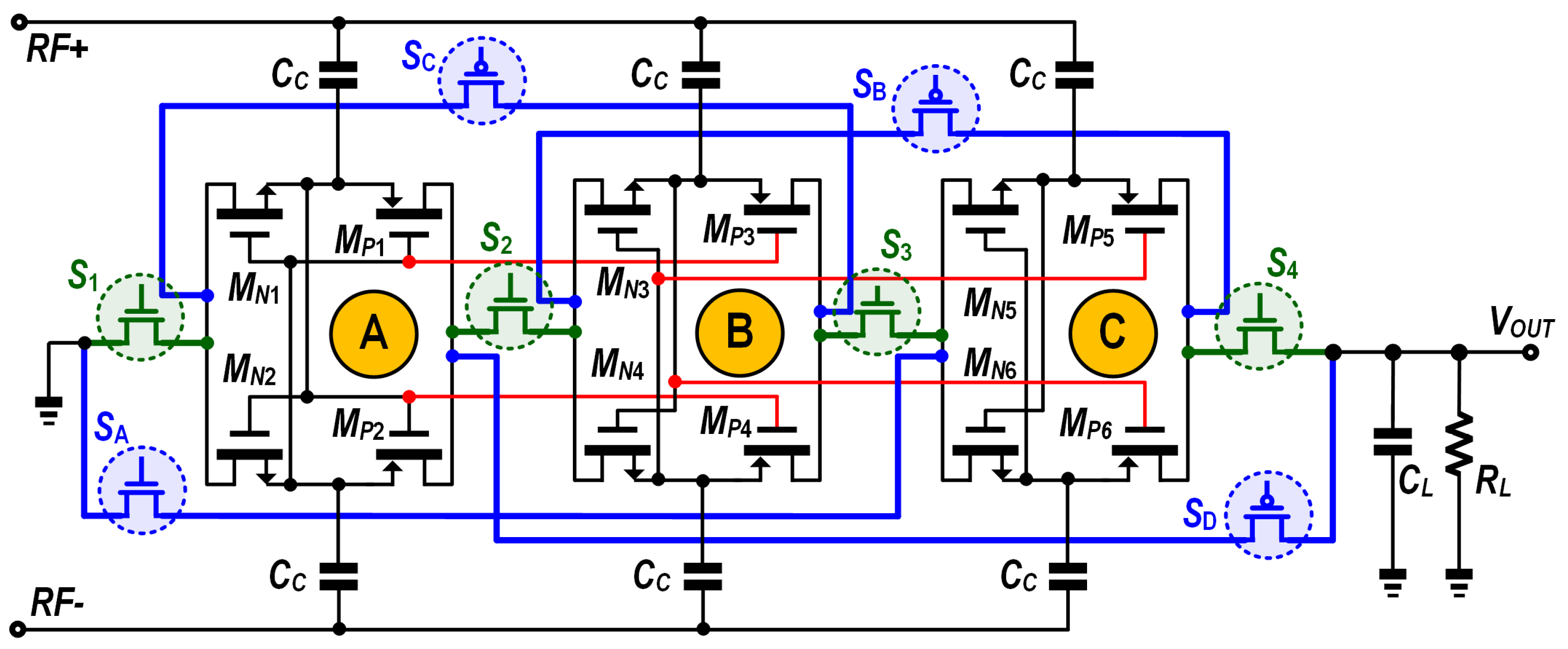
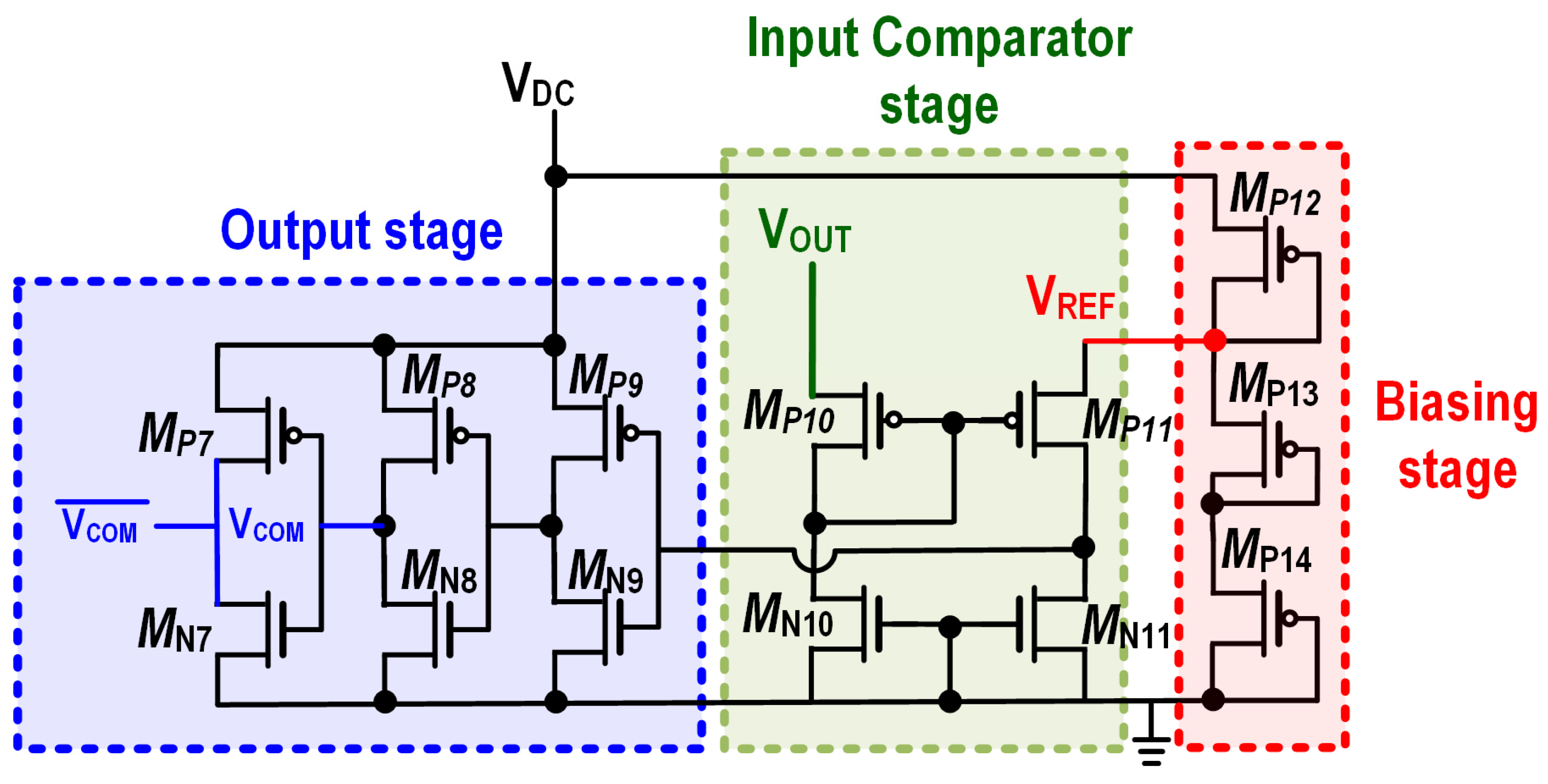
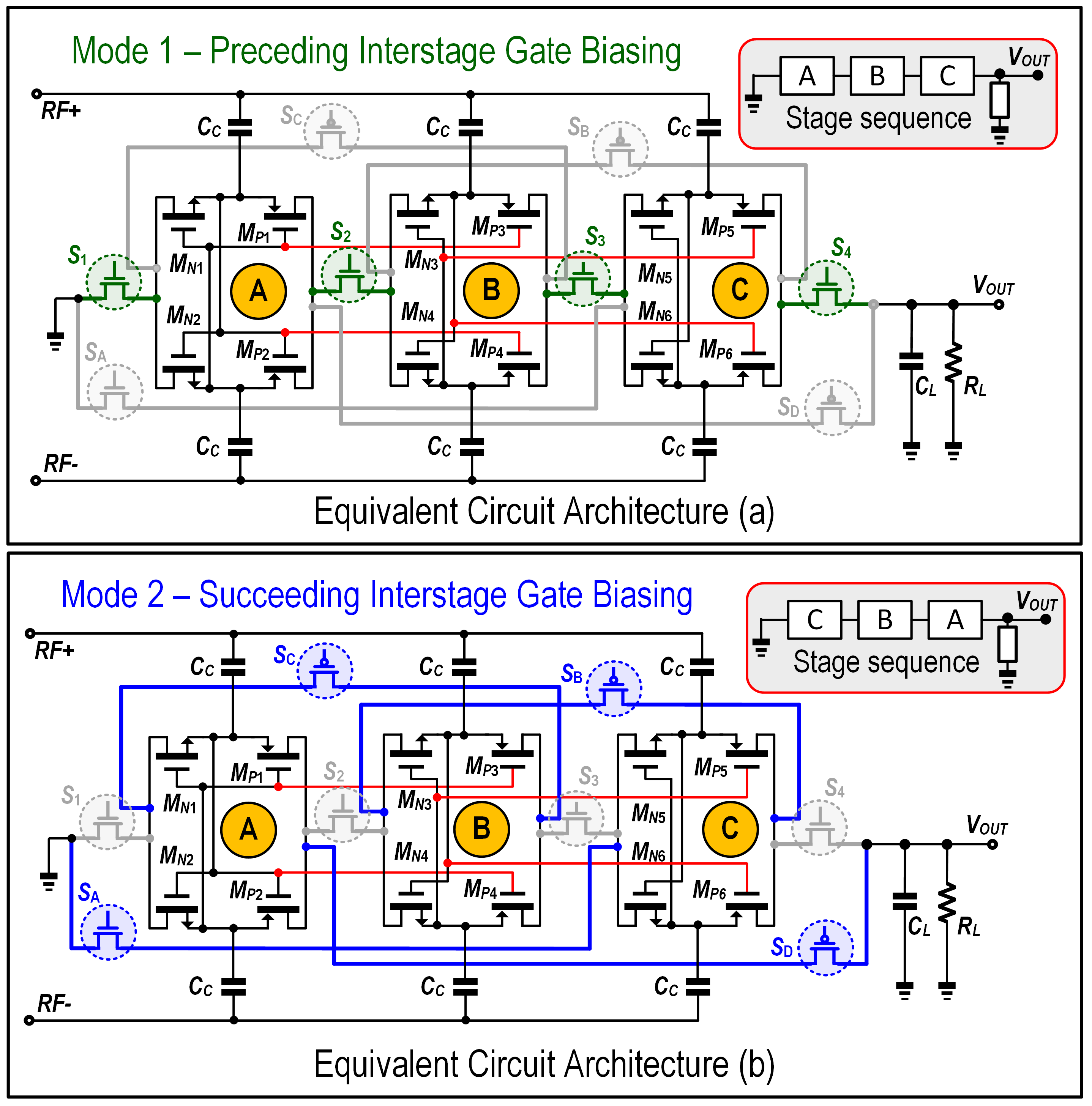


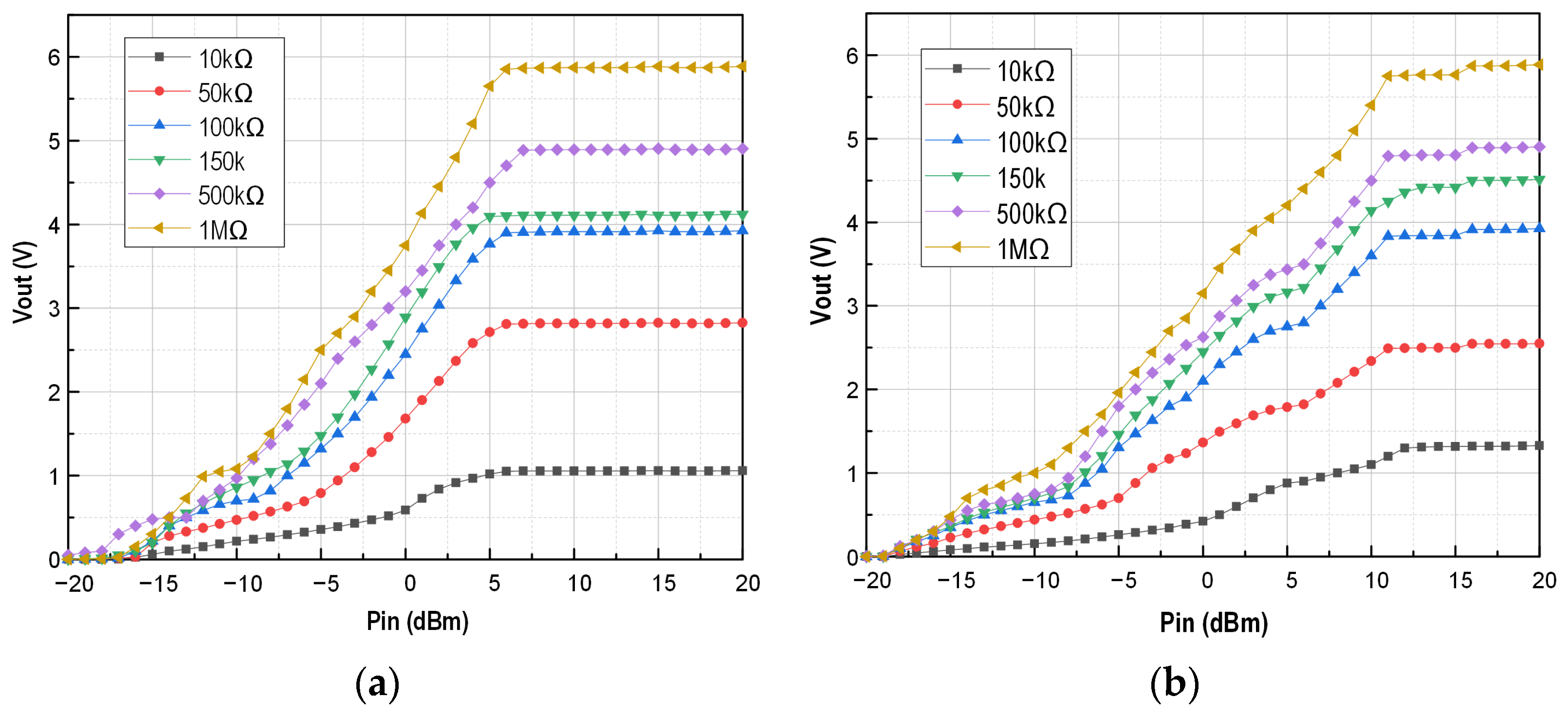
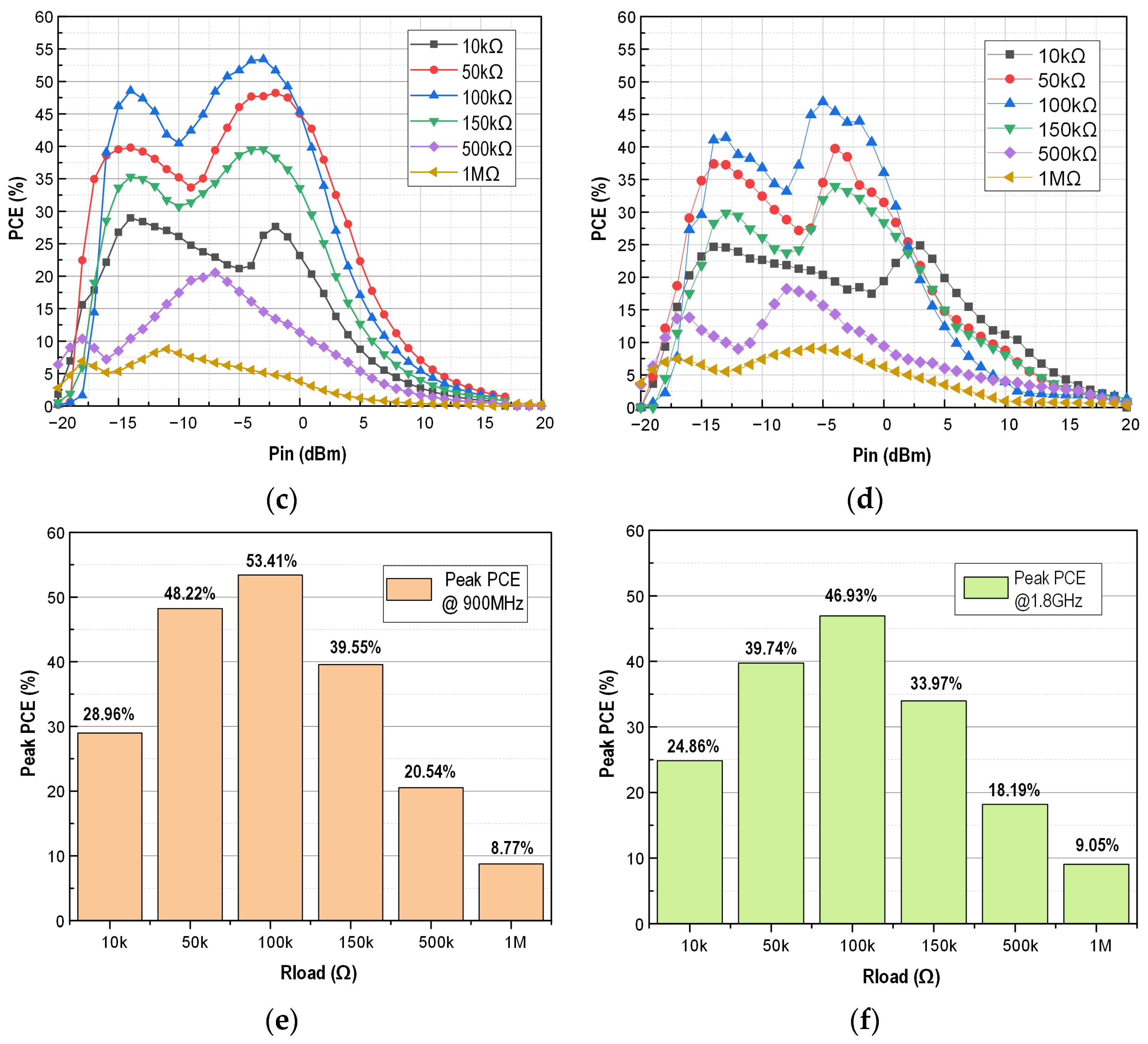
| Switches | Control Signals | Mode 1 (Low Power) Vcom = 1.2 V = 0 V | Mode 2 (High Power) Vcom = 0 V = 1.2 V |
|---|---|---|---|
| S1 (NMOS) | VCOM | ON | OFF |
| S2 (NMOS) | VCOM | ON | OFF |
| S3 (NMOS) | VCOM | ON | OFF |
| S4 (NMOS) | VCOM | ON | OFF |
| SA (NMOS) | OFF | ON | |
| SB (PMOS) | VCOM | OFF | ON |
| SC (PMOS) | VCOM | OFF | ON |
| SD (PMOS) | VCOM | OFF | ON |
| Devices | Type | Width/Length |
|---|---|---|
| MN1–MN6 | LVT | 1 µm/60 nm |
| MP1–MP6 | LVT | 2 µm/60 nm |
| S1–S4, SA | LVT | 1 µm/60 nm |
| SB-SD | LVT | 2 µm/60 nm |
| MN7–MN10 | LVT | 1 µm/60 nm |
| MP7–MP10, MN12–MN14 | LVT | 2 µm/60 nm |
| MN11, MP11 | LVT | 600 nm/60 nm |
| RL | - | 100 kΩ |
| CC | MIM | 1 pF |
| CL | MIM | 5 pF |
| [15] | [17] | [32] | [26] | [28] | This Work # | |
|---|---|---|---|---|---|---|
| CMOS Tech. (nm) | 180 | 180 | 130 | 180 | 130 | 65 |
| Frequency (MHz) | 953 | 915 | 900 | 900 | 915 | 900/1800 |
| Rectifier Topology | CCDD | CCDD | Dickson | CCDD | CCDD | CCDD |
| Proposed Technique | Conventional | Deep-n-well Body-Biasing | Reconfigurable Stages No. | Diode-Connected Gate-Biasing | Interstage Gate-Biasing | Reconfigurable Gate-Biasing |
| Rectifier Stages | 3 | 1-2-4 | 6–12 | 1 | 10 | 3 |
| Effective Area (mm2) | - | - | 0.039 | 0.0088 | 0.029 | 0.0183 |
| Output Load, RL | 100 kΩ | 2.6 kΩ | 100 kΩ | 100 kΩ | 450 kΩ | 100 kΩ |
| Sensitivity at 1 V (dBm) | −14 @ 100 kΩ | −10 @ ∞ Ω | −21.7 @ 1 MΩ | −18.2 @ 100 kΩ | −25.5 @ 5 MΩ | −15.4 @ ∞ Ω for 900 MHz −15.8 @ ∞ Ω for 1800 MHz |
| Peak PCE | 39.25% * @ −8.73 dBm | 56.7% @ 2 dBm | 34.93% @ −10 dBm | 66% @ −18.5 dBm | 42.4% @ −16 dBm | 48.8% @ −13.48 dBm for 900 MHz # 46.4% @ −14.02 dBm for 1800 MHz # |
| PDR (PCE > 20%) | 18 dB * | 8 dB | 14 dB | 15 dB | 12 dB | 20 dB # at 900 MHz 19 dB # at 1800 MHz |
Disclaimer/Publisher’s Note: The statements, opinions and data contained in all publications are solely those of the individual author(s) and contributor(s) and not of MDPI and/or the editor(s). MDPI and/or the editor(s) disclaim responsibility for any injury to people or property resulting from any ideas, methods, instructions or products referred to in the content. |
© 2025 by the authors. Licensee MDPI, Basel, Switzerland. This article is an open access article distributed under the terms and conditions of the Creative Commons Attribution (CC BY) license (https://creativecommons.org/licenses/by/4.0/).
Share and Cite
Low, Y.J.; Lee, Y.C.; Lian, W.X.; Ramiah, H. A Novel Reconfigurable Gate-Biasing Technique for Extending Dynamic Range in CMOS RF-DC Rectifiers Targeting RFEH Applications. Chips 2025, 4, 22. https://doi.org/10.3390/chips4020022
Low YJ, Lee YC, Lian WX, Ramiah H. A Novel Reconfigurable Gate-Biasing Technique for Extending Dynamic Range in CMOS RF-DC Rectifiers Targeting RFEH Applications. Chips. 2025; 4(2):22. https://doi.org/10.3390/chips4020022
Chicago/Turabian StyleLow, Yi Joe, Yi Chen Lee, Wen Xun Lian, and Harikrishnan Ramiah. 2025. "A Novel Reconfigurable Gate-Biasing Technique for Extending Dynamic Range in CMOS RF-DC Rectifiers Targeting RFEH Applications" Chips 4, no. 2: 22. https://doi.org/10.3390/chips4020022
APA StyleLow, Y. J., Lee, Y. C., Lian, W. X., & Ramiah, H. (2025). A Novel Reconfigurable Gate-Biasing Technique for Extending Dynamic Range in CMOS RF-DC Rectifiers Targeting RFEH Applications. Chips, 4(2), 22. https://doi.org/10.3390/chips4020022






